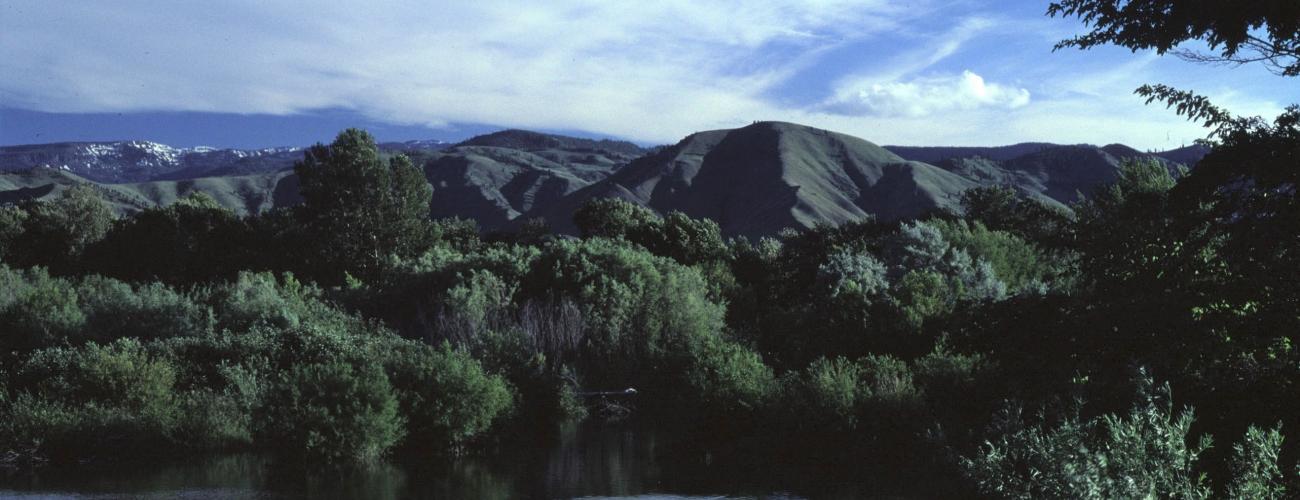Wenatchee Confluence State Park History
Two of Washington’s great rivers converge at Wenatchee Confluence State Park. This place connects different geologic terranes, Indigenous nations, fruit growers, packers and distributors, transportation networks, residents and visitors.
A Tale of Two Rivers
The Columbia River is the largest river on the Pacific Coast of North America. The river flows along the margin of the Columbia Plateau, pushed to the edge of the North Cascades by the outpouring of layers of lava that formed the plateau. At its confluence with the Wenatchee River, it is still more than 470 miles from the Pacific Ocean. The Wenatchee River begins at Lake Wenatchee in the heart of the North Cascades and flows 53 miles through precipitous Tumwater Canyon and past more arid lands to its confluence with the Columbia. In 1879, US Army Lt. Charles Erskine Scott Wood described the location:
….the mouth of the Wenatchee, in the heart of the ruggedest Alps of America. The great Columbia tore through the mountain pass in a grand sweep, tossing and foaming, This bend of the river inclosed [sic] a level plain some mile or so broad, and just opposite the blue Wenatchee came from the mountain glens to join the Columbia.
Indigenous Lands
The park lies within the traditional territories of Sahaptian and Inland Salish Indigenous people whose present-day descendants include members of the Confederated Tribes and Bands of the Yakama Nation and the Confederated Tribes of the Colville Reservation. For thousands of years this area has provided habitat for a diverse community of life that forms the basis of their cultures. In particular, the flat lands surrounding the confluence of the Wenatchee and Columbia Rivers have been a traditional meeting ground for Indigenous people from throughout the interior of today’s Washington State.
The traditional seasonal cycle of local Indigenous people includes winters spent in the shelter of the Columbia or Wenatchee River valleys and spring travel to higher parts of the Columbia Plateau for harvesting biscuitroot and other plants. Summer heralds a return to fishing stations by rapids on the rivers. Late summer brought a gathering of many people to the vicinity of today’s Wenatchee Confluence State Park for councils, trade, socializing, and horse-racing.
Some tribes ceded ownership of the area to the US federal government under duress in the Yakima Treaty of Camp Stevens in 1855, keeping rights to harvest natural resources in their usual and accustomed places, including the Wenatchee and Columbia Rivers. Other tribes and bands such as the Columbia-Moses (Sinkayuse) were subjected to a series of executive orders by US Presidents that established and dissolved reservation areas and ultimately relinquished ownership of their homelands to the US federal government.
In the late summer of 1879, US Army General O.O. Howard met with Indigenous leaders during the traditional seasonal gathering at the Wenatchee Confluence. He encouraged those who had not agreed to move to the Yakama Reservation to instead move to the Columbia Reservation established by President Rutherford B. Hayes a few months earlier. Some agreed, but those with the closest ties to the Wenatchee River valley and its fisheries declined. Ultimately, the Columbia Reservation was dissolved and most of the people moved to the Colville Reservation.
Government surveys were completed in 1884 and land in today’s park passed into private ownership with Homestead Entry Patents to Samuel Miller, David Freer and the heirs of Caleb Cooper. Miller and Freer had developed a store on the site in the 1860s which had already become a well-established trading center by the time they qualified to receive Homestead Patents.
Apples
Michael Horan arrived in the Wenatchee area in 1889, developing a cattle ranch and purchasing the Cooper and Miller properties at Wenatchee Confluence. He also developed an irrigated apple and pear orchard on the property. In 1908, he took nine varieties of his apples to a national show in Spokane, where he was awarded first prize and crowned as the National Apple King. The publicity brought wide attention to the orchards of the Wenatchee Valley, launching its reputation as the “Apple Capital of the World.”
Rock Island Dam
In 1974, the Chelan County Public Utility District (PUD), the operator of Rock Island Dam, requested an amendment to the dam operation license to build a second powerhouse with six additional generating units. The Federal Energy Regulatory Commission required the PUD to “arrange for the construction, maintenance and operation of recreational facilities” as a condition of approving the license.
PUD acquired 197 acres of ranch and orchard land from Horan Brothers, Inc. and developed a boat launch, campground and day-use area north of the Wenatchee River at the confluence. South of the river a wetland area was created from former orchards and pastures.
Making A State Park
On April 26, 1990, the Washington State Parks and Recreation Commission entered into a lease and operating agreement to manage the park built by PUD as Wenatchee Confluence State Park. The wetlands and open space south of the river was dedicated as the Horan Natural Area, reserved for low-impact recreation, outdoor education and wildlife habitat.
Sharing the histories of Washington’s state parks is an ongoing project. Learn more here.

